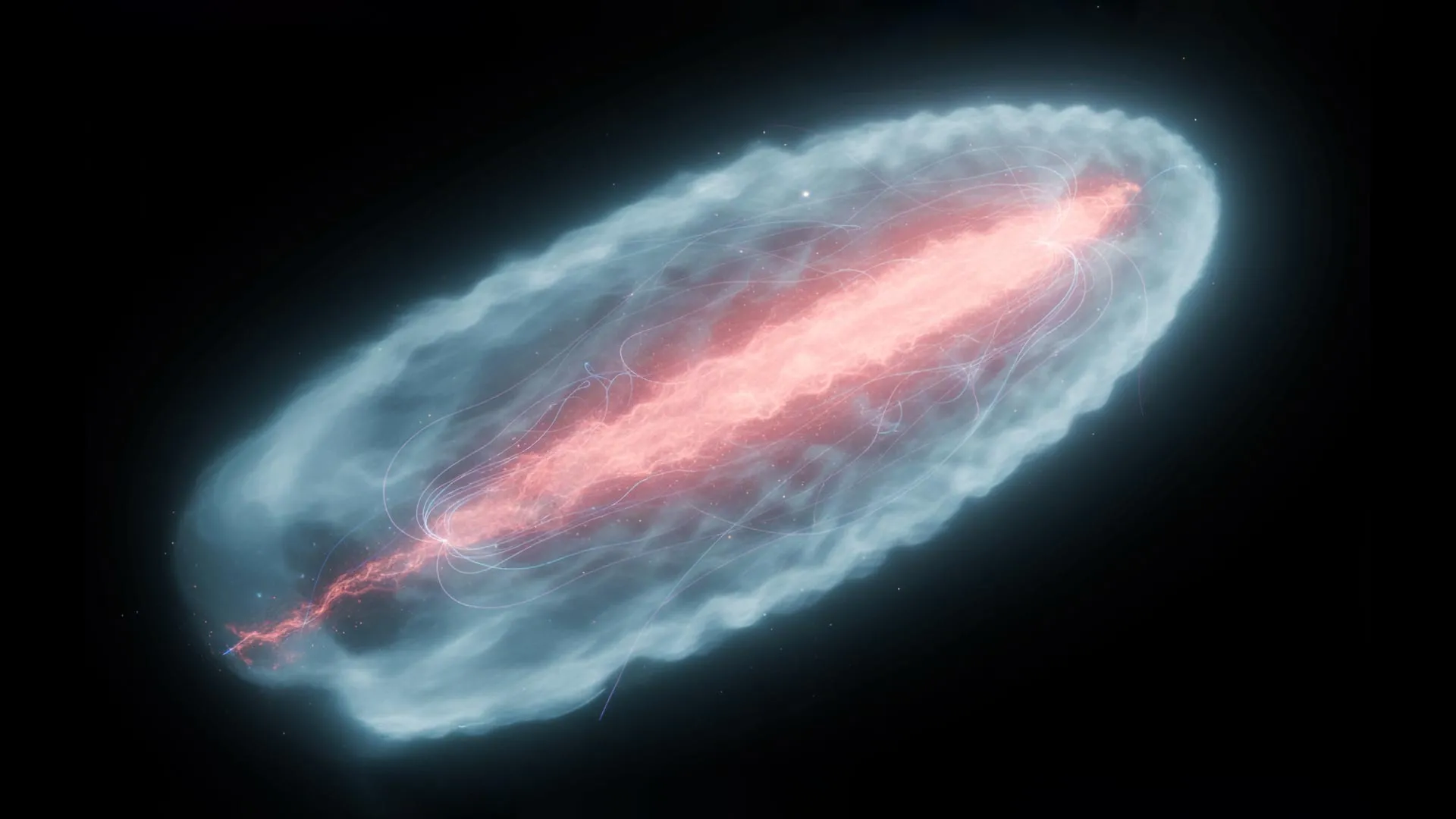CERN creates cosmic “fireballs” that could reveal the Universe’s hidden magnetism
- Date:
- November 7, 2025
- Source:
- University of Oxford
- Summary:
- Using CERN’s Super Proton Synchrotron, researchers generated plasma fireballs to simulate blazar jets. The beams stayed stable, suggesting plasma instabilities aren’t responsible for missing gamma rays. Instead, the data strengthens the idea of ancient intergalactic magnetic fields, possibly from the Universe’s earliest moments.
- Share:

An international group of researchers led by the University of Oxford has achieved a world-first by generating plasma "fireballs" with the Super Proton Synchrotron accelerator at CERN in Geneva. Their goal was to investigate how plasma jets from distant blazars remain stable as they travel through space.
The team's results, published on November 3 in PNAS, could help solve a major mystery about the Universe's missing gamma rays and its vast, invisible magnetic fields.
Blazars and the Puzzle of Missing Gamma Rays
Blazars are a type of active galaxy powered by supermassive black holes that shoot out powerful, narrow jets of particles and radiation at nearly the speed of light. These beams release extremely energetic gamma rays that can reach several teraelectronvolts (1 TeV = 1012 eV), which are detected by ground-based observatories.
As these TeV gamma rays travel across intergalactic space, they interact with faint background light from stars, producing cascades of electron-positron pairs. These pairs should then collide with the cosmic microwave background, creating lower-energy gamma rays (around 109 eV, or GeV). However, gamma-ray space telescopes such as NASA's Fermi satellite have not observed this expected signal. The cause of this discrepancy has long been unknown.
Scientists have proposed two possible explanations. One theory suggests that weak magnetic fields between galaxies deflect the electron-positron pairs, redirecting the resulting gamma rays away from Earth. Another, rooted in plasma physics, proposes that the pairs themselves become unstable while passing through the thin gas that fills intergalactic space. In this scenario, small disturbances in the plasma generate magnetic fields and turbulence that drain energy from the beam.
Recreating Cosmic Conditions in the Laboratory
To test these ideas, the research team -- combining expertise from Oxford and the Science and Technology Facilities Council's (STFC) Central Laser Facility (CLF) -- used CERN's HiRadMat (High-Radiation to Materials) setup. They produced beams of electron-positron pairs using the Super Proton Synchrotron and sent them through a one-meter-long plasma. This experiment served as a small-scale simulation of how a blazar's pair cascade moves through intergalactic matter.
By measuring the beam's shape and the magnetic fields it generated, the researchers were able to determine whether plasma instabilities could be strong enough to disrupt the beam's flow.
Surprising Results Point to Ancient Magnetic Fields
The findings were unexpected. Instead of breaking apart, the pair beam stayed tightly focused and nearly parallel, showing very little disturbance or magnetic activity. When applied to cosmic scales, this suggests that plasma instabilities alone are too weak to account for the missing gamma rays.
The outcome supports the alternative explanation -- that the intergalactic medium contains a magnetic field left over from the early Universe.
Lead researcher Professor Gianluca Gregori (Department of Physics, University of Oxford) said: "Our study demonstrates how laboratory experiments can help bridge the gap between theory and observation, enhancing our understanding of astrophysical objects from satellite and ground-based telescopes. It also highlights the importance of collaboration between experimental facilities around the world, especially in breaking new ground in accessing increasingly extreme physical regimes."
The Early Universe and the Origin of Magnetism
The results raise new questions about how such a magnetic field could have formed. The early Universe is thought to have been highly uniform, so the existence of magnetic fields from that era is difficult to explain. The researchers suggest that the answer may involve physics beyond the Standard Model. Future observatories such as the Cherenkov Telescope Array Observatory (CTAO) are expected to provide sharper data to explore these theories.
Co-investigator Professor Bob Bingham (STFC Central Laser Facility and the University of Strathclyde) said: "These experiments demonstrate how laboratory astrophysics can test theories of the high-energy Universe. By reproducing relativistic plasma conditions in the lab, we can measure processes that shape the evolution of cosmic jets and better understand the origin of magnetic fields in intergalactic space."
Co-investigator Professor Subir Sarkar (Department of Physics, University of Oxford) added: "It was a lot of fun to be part of an innovative experiment like this that adds a novel dimension to the frontier research being done at CERN -- hopefully our striking result will arouse interest in the plasma (astro)physics community to the possibilities for probing fundamental cosmic questions in a terrestrial high energy physics laboratory."
The project brought together scientists from the University of Oxford, STFC's Central Laser Facility (RAL), CERN, the University of Rochester's Laboratory for Laser Energetics, AWE Aldermaston, Lawrence Livermore National Laboratory, the Max Planck Institute for Nuclear Physics, the University of Iceland, and Instituto Superior Técnico in Lisbon.
Story Source:
Materials provided by University of Oxford. Note: Content may be edited for style and length.
Journal Reference:
- Charles D. Arrowsmith, Francesco Miniati, Pablo J. Bilbao, Pascal Simon, Archie F. A. Bott, Stephane Burger, Hui Chen, Filipe D. Cruz, Tristan Davenne, Anthony Dyson, Ilias Efthymiopoulos, Dustin H. Froula, Alice Goillot, Jon T. Gudmundsson, Dan Haberberger, Jack W. D. Halliday, Tom Hodge, Brian T. Huffman, Sam Iaquinta, G. Marshall, Brian Reville, Subir Sarkar, Alexander A. Schekochihin, Luis O. Silva, Raspberry Simpson, Vasiliki Stergiou, Raoul M. G. M. Trines, Thibault Vieu, Nikolaos Charitonidis, Robert Bingham, Gianluca Gregori. Suppression of pair beam instabilities in a laboratory analogue of blazar pair cascades. PNAS, November 2025 DOI: 10.1073/pnas.2513365122
Cite This Page: